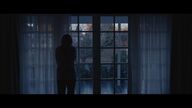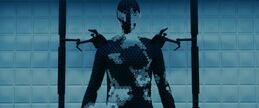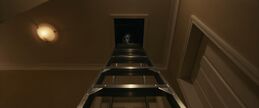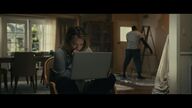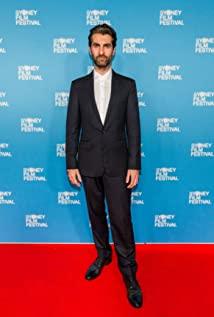Viewing rights (power/right) is one of the core themes explored in this film. The film uses a positive and negative shot facing the void, which repeatedly leads the viewing line back to the heroine (/camera) herself. This "absolute counter attack" of the empty/back shot is usually achieved through an open door. As a boundary/connection space between partition and transparency, interior and exterior, the door frame becomes a kind of "visible invisible" and "seen to be seen". The window, screen and mirror conceal the heroine, the hero and the camera/audience: the heroine who repeatedly appears in the window becomes a transparent object to be seen; the hero who manipulates the viewing rights and is exempted from the obligation to be seen is the one who keeps watch. It also blocks the "screens" of others; the camera's reflexive "absolute counterattack" reveals the mirror image of the audience itself.
The "ghost point of view" brought about by the panning lens enhances the non-human nature of the film/camera , blurring the lines between human and non-human, flesh and machine, it is " becoming - machine". If the panning camera/male protagonist is an "organ without a body", then the female protagonist's subjective shot is a "body without an organ", and the latter is reduced to a "body with an organ" under the control of the former. , turned into a "corpse" deprived of the right to see in a cybernetic society. For the male protagonist, the assembling of man and machine makes him a "video cyborg" that manipulates viewing rights (this is not only because his invisibility cloak is composed of countless small lenses on the object being viewed) composition, but also his invisibility to the camera and the audience). A male-organ-screen and female-body-window appear, the former's condition for making itself (transparent) invisible is precisely the layer of "screen" that blocks the viewer, while the latter's transparency makes it appear. A clearly visible (blocked) "body object".
When the male protagonist appears and the female protagonist walks into the aisle of her mansion, it is still an empty mirror facing the open door, but this time it is the back of the female protagonist who appears in the camera, followed by a front and back shot. Later, the male protagonist appeared in the door frame. As the male and female protagonists blocked the "emptiness", the male protagonist lost the right to watch, and the female protagonist regained the right to watch and became an actor. This is the final moment when the audience loses the right to watch, because the inhumanity of the generative-machine, the nomadic without bodily organs is gone, and only the anti-kill routine of realism remains (this is also the shortcoming of the film structure itself). When the heroine uses the medicinal power of cyborg, an extracorporeal technology, to counter-kill, the audience is poisoned by the camera-movie image cyborg. We are infiltrated by "viewing ideology" and are finally forgiven in the last scene. The heroine closed her eyes, the screen was black, and the lights were on.
However, the "female anti-kill" plot of the film itself can bring another ideological crack and the initiative of the passive. This is "becoming-female (/weak)" after "becoming-machine", the heroine begins to "escape" in the flow of becoming (becoming), and then reassembles into a new becoming -female-machine. At the end, the invisibility cloak hidden in her bag and the suspicious expression of the second male lead to another interpretation and heterogeneity space, which may also be the sequel "Easter Egg" of the whole series.
View more about The Invisible Man reviews



